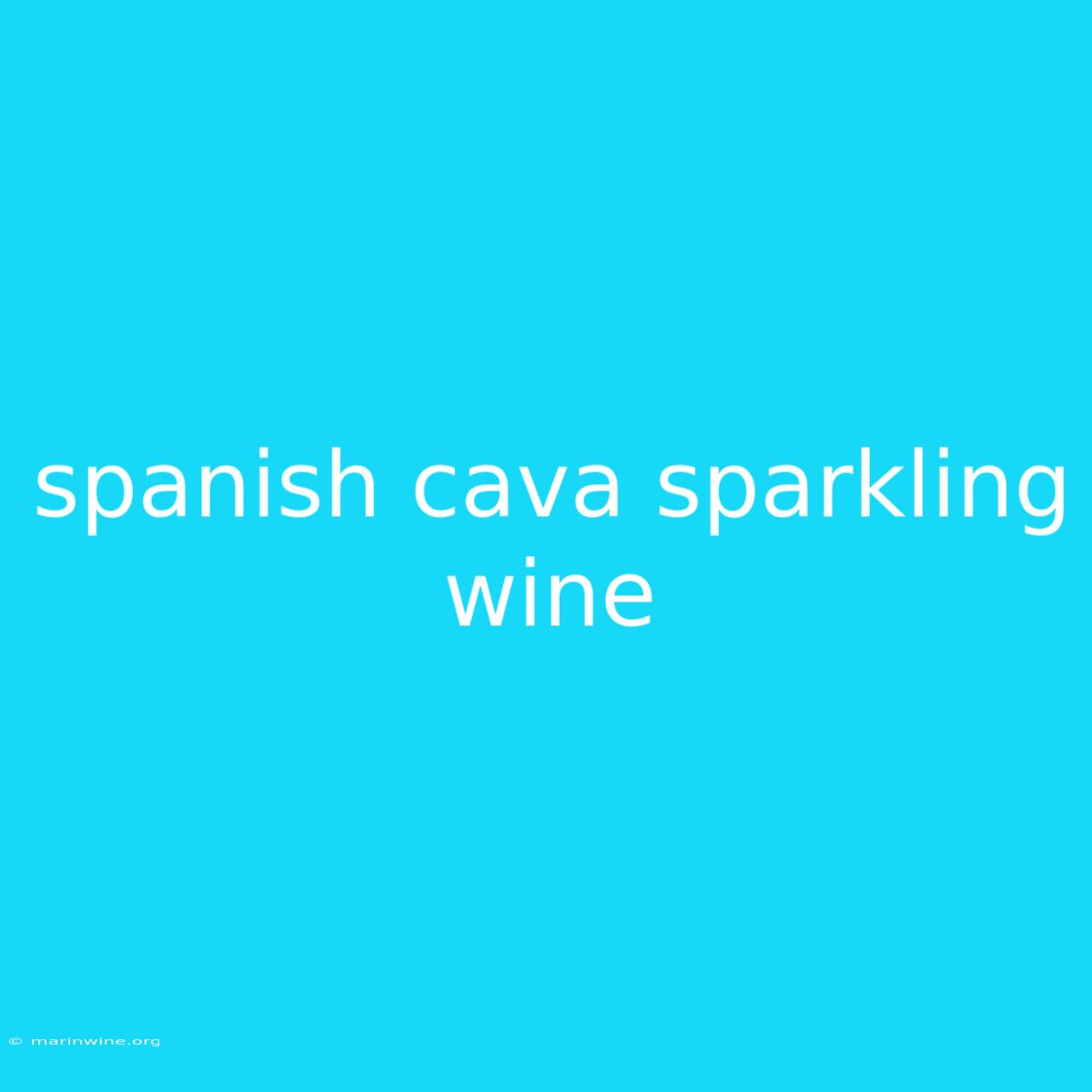Uncorking the Secrets of Spanish Cava: More Than Just Sparkling Wine
Have you ever wondered what makes Spanish Cava so special? It's not just sparkling wine; it's a celebration of tradition, terroir, and a unique production method that elevates it to an esteemed category of its own.
Why It Matters: Cava is not just a delicious bubbly drink; it's a testament to Spanish winemaking prowess. It embodies a centuries-old tradition, utilizing the same "méthode champenoise" as champagne, yet showcasing distinct flavor profiles and a compelling story. This article dives into the world of Spanish Cava, exploring its history, production process, and the key characteristics that make it a beloved choice for wine enthusiasts.
Key Takeaways of Cava:
| Feature | Description |
|---|---|
| Origin | Produced primarily in the Penedès region of Catalonia, Spain |
| Production | "Méthode champenoise" - secondary fermentation in the bottle |
| Grape Varieties | Macabeo, Parellada, Xarel-lo |
| Styles | Brut, Brut Nature, Reserva, Gran Reserva |
| Flavor Profile | Fresh, fruity, with notes of citrus, apple, and brioche |
Spanish Cava: A Legacy of Sparkling Wine
Cava's history stretches back centuries, with evidence of winemaking in the Penedès region dating back to the Roman era. However, it wasn't until the 19th century that the modern production of Cava, using the "méthode champenoise", truly took shape. Inspired by the success of Champagne in France, Catalan winemakers began experimenting with this meticulous process, resulting in a vibrant and sophisticated sparkling wine that quickly gained international recognition.
The Essence of Cava: From Grapes to Bottle
Cava's unique character stems from its meticulous production process:
1. Grape Selection: The primary grapes for Cava are Macabeo, Parellada, and Xarel-lo, each contributing distinct flavor profiles:
* **Macabeo:** Provides structure and acidity
* **Parellada:** Offers floral aromas and freshness
* **Xarel-lo:** Adds richness and complexity
2. Traditional "Méthode Champenoise": Cava undergoes a second fermentation in the bottle, where yeast transforms sugar into carbon dioxide, creating the signature bubbles. This process can take anywhere from 9 to 30 months, depending on the style and aging requirements.
3. Styles of Cava: Cava is available in various styles, offering a diverse range of flavor profiles and aging periods:
* **Brut:** The most common style, with less than 12g/L of residual sugar.
* **Brut Nature:** The driest style, with less than 3g/L of residual sugar.
* **Reserva:** Aged for at least 15 months, offering more complexity.
* **Gran Reserva:** Aged for at least 30 months, exhibiting rich and mature flavors.
Cava's Unique Character: Beyond the Bubbles
Cava's elegance lies not just in its bubbly character, but in its nuanced flavors:
- Fresh & Fruity: Expect notes of citrus, green apple, pear, and ripe berries.
- Floral Hints: Delicate floral aromas add another layer of complexity.
- Bread-like Notes: The secondary fermentation imparts hints of brioche, toast, and yeasty flavors.
The Connection Between Terroir & Cava's Flavors:
The Penedès region's diverse landscape - a combination of mountains, valleys, and coastal plains - plays a crucial role in shaping Cava's distinct characteristics:
- Climate: The Mediterranean climate with warm, sunny days and cool nights provides ideal conditions for grape growth.
- Soil: The region's soils, primarily chalky and clay-rich, contribute to the wines' minerality and acidity.
Cava & Food Pairing: Elevating the Culinary Experience
Cava's versatility makes it an ideal accompaniment to a wide range of cuisines:
- Appetizers: Enjoy it with tapas, charcuterie, and seafood.
- Main Courses: Pair it with pasta dishes, grilled chicken, and fish.
- Desserts: Cava's dryness complements sweet treats like fruit tarts and chocolate desserts.
FAQ for Spanish Cava
1. What is the difference between Cava and Champagne?
While both are produced using the "méthode champenoise", Cava is typically made with different grape varieties and often exhibits a more fruit-forward character than Champagne.
2. How can I tell if Cava is good quality?
Look for reputable producers, check for labels like Reserva or Gran Reserva, and consider the awards or accolades the Cava has received.
3. Is Cava more affordable than Champagne?
Generally, yes. Cava is often more affordable than Champagne, making it an excellent choice for those seeking value and quality.
Tips for Enjoying Spanish Cava:
- Chill It Properly: Serve Cava chilled, between 6°C and 8°C (43°F and 46°F) for optimal enjoyment.
- Use the Right Glass: A flute or a coupe glass will enhance the sparkling experience.
- Pair It Wisely: Consider the style of Cava and the dish you're serving it with.
- Appreciate the Bubbles: Notice the fine, persistent bubbles that rise from the bottom of the glass.
Summary of Spanish Cava:
Spanish Cava is a testament to Spanish winemaking tradition and a delicious, versatile sparkling wine. Its production, grape varieties, and unique flavor profile distinguish it from other sparkling wines. Cava is a celebration of quality, tradition, and the elegance of bubbles.
Mensaje de cierre: Uncorking a bottle of Spanish Cava is more than just a toast; it's an invitation to experience a centuries-old legacy, a commitment to quality, and the captivating world of Spanish sparkling wine.
Remember to use the information provided in this article to create your own unique and SEO-optimized blog post about Spanish Cava. Feel free to add your own insights, examples, and even personal experiences to make your article even more engaging and informative.

